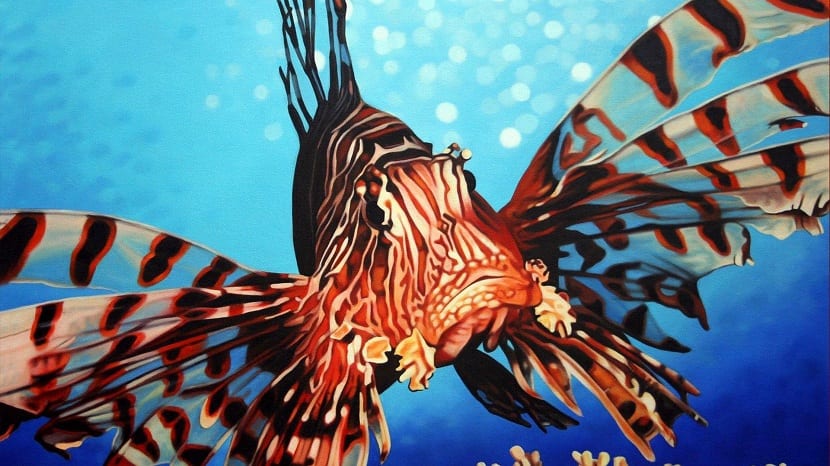
Today we are going to talk about a fish whose appearance stands out mainly for its showiness and danger. It's about the lionfish. It is a fish that usually lives in warmer waters and is poisonous. It has caused countless deaths to animals and numerous damages to humans. Scientific name Pterois antennata and belonging to the Scorpanidaes family, we present you the lionfish.
Do you want to know all the characteristics of this fish and where it is found?
Lionfish characteristics
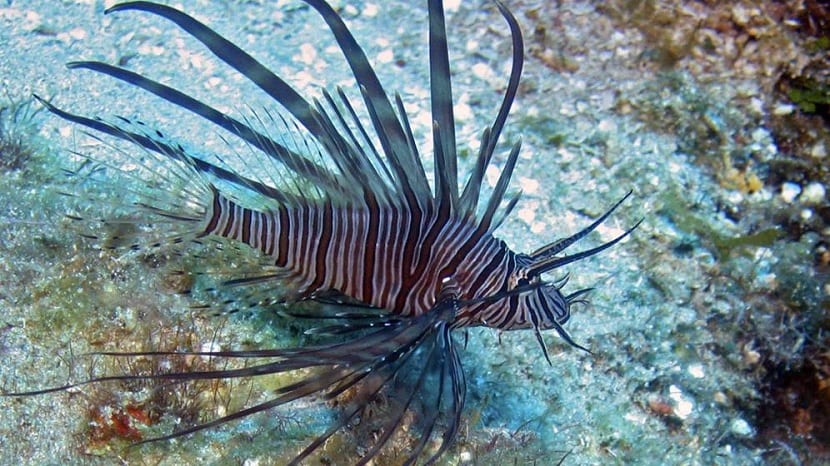
It is quite possible that this fish was accidentally incorporated into the waters of the Mediterranean Sea and, as an invasive species, it has become a plague and a great affection for other marine species and for coastal tourism.
And, although this fish does not exceed 20 cm in length and its weight is rarely more than one kilogram, it is extremely showy and dangerous. It has very long pectoral fins and has a very varied color, among which the red, orange and its unmistakable black stripes stand out.
The whole appearance of this fish is a sign of danger for other species that inhabit warmer waters. Their dorsal fins have rays that lack a membrane between them, although the pectoral rays do. It has long antennae above the eye that simulate horns and makes this fish look even more dangerous.
Its main defense weapon resides in its 18 dorsal fins, since they are sharp. Through the tips of the fins, it expels a poison that, for species of a smaller size, is deadly. When the bite of this fish affects larger organisms such as humans, it is capable of causing severe pain in the affected area, breathing problems and nausea.
Distribution and habitat
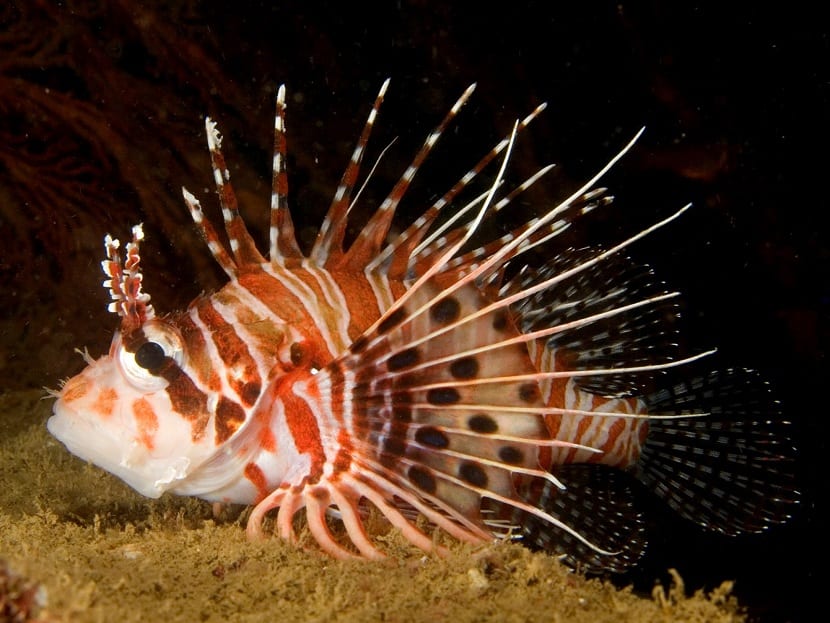
Originally the lionfish inhabits the areas with warmer waters of the rocky areas and coral reefs of the Indian and Pacific. After some loss with some species, some navigation in which the fish remained anchored, a fishing net or other possible sources of displacement, this fish is found in large shoals plowing through the waters of the Atlantic Ocean, the Caribbean Sea and the Mediterranean.
Many species de peces, crustaceans and mollusks travel attached to the hull of ships and manage to move from their natural habitat. If the place where they arrive has conditions that are conducive to their reproduction and good condition, this species will begin to spread as if it were a plague and can affect native species, displacing them from their ecosystem.
These fish reproduce very quickly and due to the indiscriminate and illegal fishing of predatory species of lionfish, such as shark, has caused this fish to spread to many places around the planet and become a plague and threat for fish species from areas near coral reefs.
Food
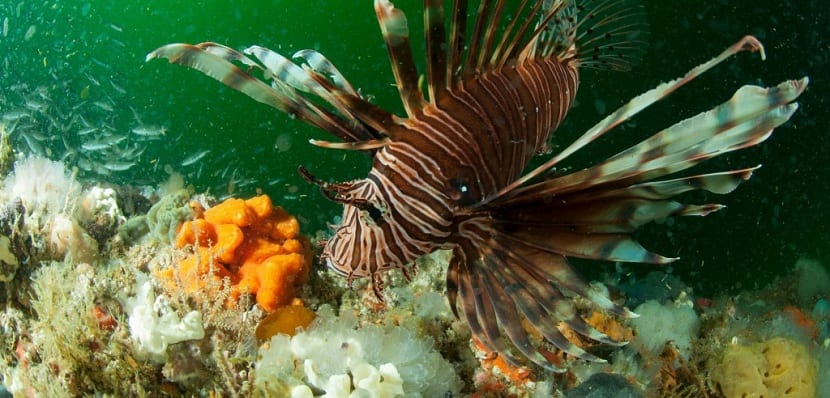
Lion fish it is mainly carnivorous. Hunt large numbers of shrimp, crustaceans, and other fish. Thanks to its light weight and its poisoned dorsal fins, it has a great ability to hunt its prey. Due to its appearance and colors, it can be camouflaged near rocks with great precision and when hunting, it has a great assault speed.
It usually lives alone and is very territorial. They generally hunt at night or early in the morning to better hide and have a greater chance of success. To rest and hide from predators they hide between the crevices of the rocks where they get a great hiding place.
Reproduction
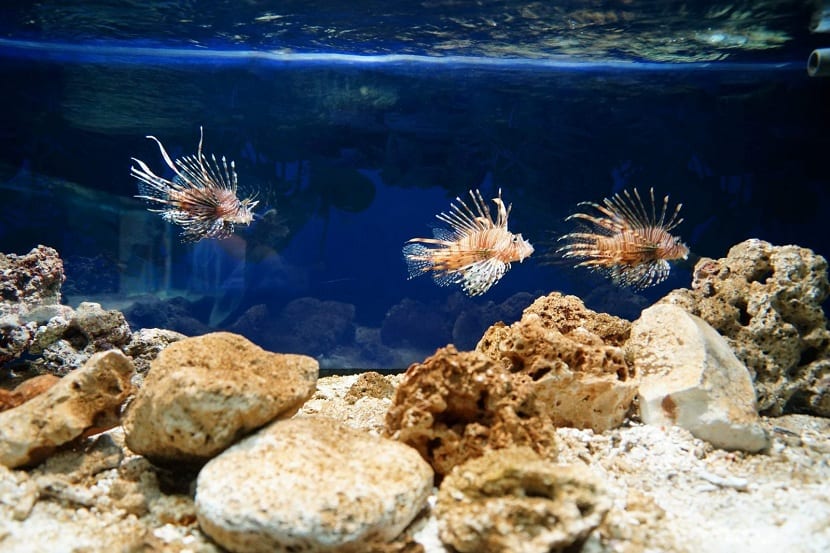
The lionfish have a group reproduction. And it is that, during mating, the males form a group where they fertilize up to eight females. The mating groups are totally closed and very territorial so, when lionfish are mating, it is very dangerous to approach their area. If a male tries to enter the group when they are mating, there will be a relentless fight where one of them will probably end up dead. The winner of that fight will have the right to enter the group of females.
The females are capable of spawning between two thousand and fifteen thousand eggs and the young are born just two days after laying their eggs, hence their rapid reproduction. Although most of the eggs that the female lays are consumed by predators, the population growth experienced by the species is brutal.
In places where this species frequently inhabits, lionfish population control plans are being implemented to restore the ecological balance of the waters and not damage the relationship between marine species and their functionality.
Gastronomy

Despite the fact that the lionfish is poisonous, it is well known in international gastronomy. Same as him Blowfish, the fish is caught for culinary purposes and to regulate the populations.
Dishes made with lionfish are highly valued, both for its delicate flavor and for its preparation techniques so refined that only the most expert are capable of cooking it.
You have to be very careful with the toxins from the venom found in their fins, as they also exist in their guts and could be fatal if consumed. The experts who work to cook lionfish have to do it in a very delicate way in order to remove all the glands that have the poison. If one of the glands ruptures, all the whole fish will be unusable for the kitchen.
They first spread to Japan, although today there are campaigns that promote their use in the gastronomy of many countries near the Caribbean Sea.
As you can see, the lionfish is a dangerous species both for the species that inhabit its ecosystems and for the people who want to consume it. It is important to regulate the populations of these fish so that their affection is minimal and the ecological balance is restored.